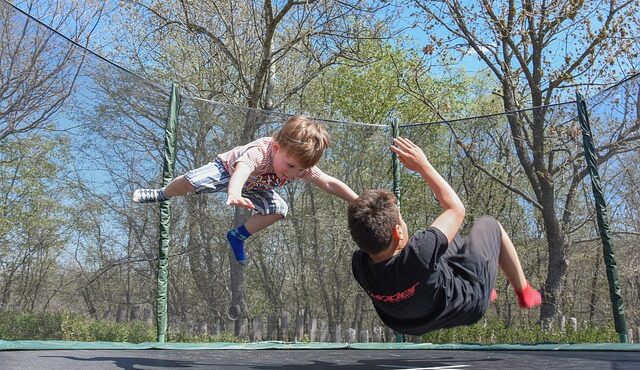Childproofing your home is essential if you want to give your kids a safe place to grow up. Safety measures and secured areas are just a few of the many steps you can take to keep your kids safe.
Let us talk about what it takes to make your home a safe place for kids and toddlers.
1. Childproofing Your Home
Childproofing your home is a crucial step in ensuring the safety and well-being of your children. It involves identifying potential hazards and taking proactive measures to mitigate risks.
Here’s a comprehensive guide to childproofing your home to create a safe and secure environment for kids and toddlers:
a. Understanding the Basics of Childproofing
Childproofing starts with a thorough assessment of your home’s layout and potential dangers. Key areas to focus on include:
- Safety Gates: Install safety gates at the top and bottom of staircases to prevent falls. Choose gates that are sturdy and securely fastened to the walls.
- Outlet Covers: Cover electrical outlets with safety plugs or outlet covers to prevent accidental shocks or electrocution. Ensure that all exposed outlets are properly secured.
- Cabinet Locks: Use cabinet locks to prevent children from accessing hazardous items such as cleaning products, sharp objects, and medications. Secure cabinets in the kitchen, bathroom, and any other areas where dangerous items are stored.
b. Securing Hazardous Areas
Certain areas of the home pose significant risks to children and require extra attention when childproofing. Here are some essential tips for securing hazardous areas:
Kitchen Safety: The kitchen is filled with potential dangers, from sharp objects to hot surfaces. Here’s how to make it safer:
- Install childproof locks on cabinets and drawers containing knives, scissors, and other sharp utensils.
- Use stove knob covers to prevent children from accidentally turning on burners.
- Consider installing a stove guard to create a barrier between children and hot pots and pans.
- Store cleaning products and chemicals in locked cabinets or high shelves out of reach of children.
Bathroom Safety: The bathroom can also present various hazards, including drowning risks and chemical exposure. Take these precautions to ensure bathroom safety:
- Install a toilet lock to prevent young children from opening the toilet lid and potentially falling in.
- Use non-slip mats in the bathtub or shower to prevent slips and falls.
- Store medications, vitamins, and other potentially harmful substances in locked cabinets or high shelves.
- Keep electrical appliances, such as hairdryers and curling irons, unplugged and stored out of reach when not in use.
2. Creating Safe Play Areas
Ensuring that your home provides safe play areas for children is essential for their physical and emotional development. Here are some key considerations for creating safe play areas:
a. Designing a Safe Playroom
A dedicated playroom can be an excellent space for children to engage in creative play while staying safe. Here’s how to design a safe playroom:
- Playroom Safety: Ensure that the playroom is free of hazards such as sharp edges, small objects that could be choking hazards, and unstable furniture. Use corner guards on furniture to prevent injuries from accidental bumps.
- Soft Flooring: Choose soft flooring options such as foam mats or carpeting to cushion falls and reduce the risk of injuries. Avoid hard surfaces like tile or hardwood, especially in areas where children are likely to play.
- Toy Storage: Keep toys organized and stored in sturdy containers or bins to prevent clutter and tripping hazards. Use childproof latches on toy chests to prevent pinched fingers or accidental entrapment.
- Age-Appropriate Toys: Select toys that are suitable for your child’s age and developmental stage. Avoid toys with small parts that could pose choking hazards, and regularly inspect toys for signs of wear or damage.
b. Outdoor Safety Measures
Outdoor play offers numerous benefits for children, but it’s essential to ensure that outdoor play areas are safe and secure. Here are some outdoor safety measures to consider:
- Playground Safety: Regularly inspect playground equipment for signs of wear or damage, and make any necessary repairs promptly. Ensure that playground surfaces are soft and shock-absorbent, such as mulch, sand, or rubber mats, to cushion falls.
- Outdoor Fencing: Install fencing around outdoor play areas to prevent children from wandering off and to keep them safe from potential hazards such as traffic or bodies of water. Ensure that fences are sturdy and have self-closing gates.
- Sun Protection: Provide adequate sun protection, such as sunscreen, hats, and sunglasses, when children are playing outdoors. Seek shade during peak sun hours, and encourage children to stay hydrated.
- Supervision: Always supervise children during outdoor play to ensure their safety. Keep a watchful eye on them, especially around water features or when using playground equipment.
3. Preventing Accidents and Injuries
Preventing accidents and injuries is a top priority for ensuring the safety of children in the home. Here are some proactive measures you can take to minimize risks:
a. Educating Kids on Safety Rules
Empowering children with knowledge about safety rules and procedures is essential for their protection. Teach them about:
- Safety Rules: Educate children about basic safety rules, such as looking both ways before crossing the street, not talking to strangers, and wearing helmets while biking or skating.
- Stranger Danger: Teach children to be cautious around strangers and to never accept gifts, rides, or invitations from someone they don’t know.
- Fire Safety: Practice fire drills with your children and teach them how to respond in case of a fire, including how to stop, drop, and roll, and how to safely exit the home.
- Emergency Procedures: Ensure that children know how to call for help in an emergency and teach them important phone numbers, such as 911. Role-play different emergency scenarios to help them feel prepared.
b. Supervision and Vigilance
Active supervision is crucial for preventing accidents and injuries, especially with young children who may not fully understand potential dangers. Here are some tips for effective supervision:
- Supervision: Keep a close eye on children at all times, especially around water, near roads, or when engaging in activities with potential hazards.
- Child Monitoring: Use baby monitors or video surveillance systems to keep tabs on children, especially when they are sleeping or playing in another room.
- Pool Safety: Install fencing around pools and use door alarms to prevent unsupervised access. Enroll children in swimming lessons at an early age and ensure that they always wear flotation devices when near water.
c. First Aid Preparedness
Being prepared to respond to medical emergencies is essential for safeguarding children’s health and well-being. Here’s how you can ensure first aid preparedness:
- First Aid Kit: Keep a well-stocked first aid kit in your home and familiarize yourself with its contents. Regularly check and replenish supplies as needed.
- CPR Training: Consider taking a CPR and first aid training course to learn life-saving skills that could make a difference in an emergency situation.
- Emergency Numbers: Keep a list of emergency contact numbers, including poison control, your pediatrician, and local emergency services, posted in a visible location.
- Poison Control: Educate children about the dangers of ingesting harmful substances and keep toxic items such as cleaning products and medications securely locked away.
4. Technology and Smart Home Integration
In today’s digital age, technology plays a significant role in enhancing home safety, including the protection of children. Let’s explore how smart devices and home automation can be utilized to ensure the safety of kids and toddlers.
a. Utilizing Smart Devices for Child Safety
Smart devices offer innovative solutions for child safety within the home environment. Here are some key technologies to consider:
- Smart Locks: Install smart locks on doors to prevent unauthorized access and enhance security. Smart locks can be controlled remotely via smartphone apps, allowing you to lock or unlock doors from anywhere.
- Video Doorbells: Video doorbells provide real-time video and audio surveillance of your home’s entry points. They allow you to see and communicate with visitors remotely, providing an extra layer of security and peace of mind.
- Security Cameras: Indoor and outdoor security cameras offer continuous monitoring of your home’s surroundings. Choose cameras with features such as motion detection and night vision to enhance surveillance capabilities.
- Smart Baby Monitors: Smart baby monitors offer advanced features such as high-definition video streaming, two-way audio communication, and temperature and humidity sensors. They allow parents to monitor their child’s safety and well-being from anywhere via smartphone apps.
b. Monitoring Systems and Alerts
In addition to smart devices, monitoring systems and alerts can provide valuable insights and notifications regarding potential safety threats. Here’s how:
- Motion Sensors: Install motion sensors throughout your home to detect movement and activity. Integrated with smart home systems, motion sensors can trigger alarms or send notifications to your smartphone in the event of unexpected activity.
- Alarm Systems: Invest in a comprehensive alarm system that includes door and window sensors, glass break detectors, and sirens. Alarm systems can deter intruders and alert you to potential security breaches.
- Mobile Alerts: Receive real-time alerts and notifications on your mobile device regarding security events or emergencies. Mobile alerts allow you to take immediate action and stay informed about the safety of your home and family.
- Remote Monitoring: Access live video feeds and monitoring data from your smart devices and security systems remotely via smartphone apps or web interfaces. Remote monitoring enables you to keep an eye on your home and children even when you’re away.
5. Educating and Empowering Parents
Empowering parents with knowledge and resources is crucial for creating a safe environment for children. Let’s explore how parents can stay informed and proactive in ensuring the safety of their little ones:
a. Keeping Parents Informed
Keeping up-to-date with parenting tips and safety resources is essential for informed decision-making. Here’s how parents can access valuable information:
- Parenting Tips: Stay informed about the latest parenting tips and advice related to child safety. Online resources, parenting blogs, and reputable parenting publications are valuable sources of information.
- Safety Resources: Utilize safety resources provided by organizations such as the National Safety Council, Safe Kids Worldwide, and the American Academy of Pediatrics. These organizations offer valuable resources, guides, and educational materials on child safety topics.
- Online Communities: Join online parenting communities and forums where parents can share experiences, ask questions, and exchange tips and advice on child safety. These communities provide a supportive network of fellow parents who understand the challenges and concerns of raising children.
- Support Networks: Build a support network of family, friends, and neighbors who can offer assistance and advice when needed. Having a support system in place can provide reassurance and help parents navigate the ups and downs of parenting.
b. Regular Safety Assessments
Regular safety assessments and home inspections are essential for identifying potential hazards and making necessary updates to ensure a safe environment for children.
Here’s how parents can conduct safety assessments:
- Safety Checklist: Use a comprehensive safety checklist to systematically evaluate potential safety hazards in your home. Address areas such as childproofing, fire safety, emergency preparedness, and outdoor safety.
- Home Inspections: Conduct regular home inspections to identify any safety concerns or maintenance issues that may pose risks to children. Check for loose handrails, frayed electrical cords, and other hazards that may need attention.
- Reassessment and Updates: Regularly reassess your safety measures and make updates as needed to address changing circumstances or new safety concerns. Stay informed about recalls or safety alerts for children’s products and make any necessary adjustments.
Conclusion
In conclusion, ensuring the safety of our children requires proactive efforts from parents to stay informed, assess risks, and take necessary precautions.
By educating and empowering parents with valuable resources and knowledge, we can create a safe haven where our little ones can thrive and grow.
Let’s continue working together to prioritize the safety and well-being of our children, our most precious treasures.

